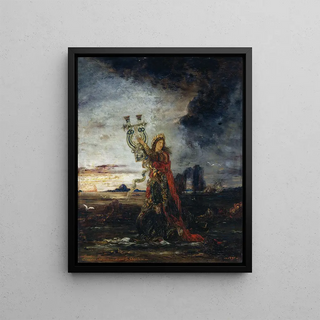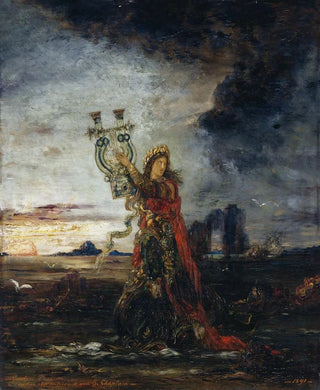Art print | Arion - Gustave Moreau


View from behind

Frame (optional)
Art print Arion - Gustave Moreau – Captivating Introduction
Gustave Moreau's "Arion" is an invitation to immerse oneself in a universe where myth and poetry intertwine. This captivating depiction of Arion, the poet and musician from Greek mythology, evokes a moment of dramatic tension and intense emotion. Moreau, through his symbolist approach, manages to transcend the simple mythological narrative to offer a reflection on the human condition, destiny, and art. The scene depicts Arion, surrounded by marine creatures, about to be saved by a dolphin, a symbol of protection and redemption. This piece, rich in colors and meanings, invites viewers to question the relationship between art and life.
Style and uniqueness of the work
Gustave Moreau's style is distinguished by a bold use of color and meticulous attention to detail. In "Arion," vibrant hues and ornate patterns create an atmosphere that is both mystical and enchanting. The figures are stylized, almost ethereal, giving the scene a dreamlike quality. Moreau excels in portraying emotions, capturing the melancholy and fleeting beauty of the moment. The composition is carefully orchestrated, with each element contributing to the overall harmony of the piece. Influences from ancient art and the Renaissance subtly blend, reflecting a rich artistic culture and an unceasing quest for beauty. This fusion of styles, combined with the symbolic depth of the work, makes it a unique piece that continues to fascinate art enthusiasts.
The artist and his influence
Gustave Moreau, an emblematic figure of the symbolist movement, left his mark on his era with an innovative approach to painting. Born in the 19th century, he established himself as a pioneer in exploring mythological themes and human emotions. His work goes beyond mere representation; it seeks to evoke sensations and provoke deep reflections. Moreau influenced many artists, notably by encouraging a more personal and introspective vision of art. His studio, a true crucible of ideas, saw emerging talents such

Matte finish

View from behind

Frame (optional)
Art print Arion - Gustave Moreau – Captivating Introduction
Gustave Moreau's "Arion" is an invitation to immerse oneself in a universe where myth and poetry intertwine. This captivating depiction of Arion, the poet and musician from Greek mythology, evokes a moment of dramatic tension and intense emotion. Moreau, through his symbolist approach, manages to transcend the simple mythological narrative to offer a reflection on the human condition, destiny, and art. The scene depicts Arion, surrounded by marine creatures, about to be saved by a dolphin, a symbol of protection and redemption. This piece, rich in colors and meanings, invites viewers to question the relationship between art and life.
Style and uniqueness of the work
Gustave Moreau's style is distinguished by a bold use of color and meticulous attention to detail. In "Arion," vibrant hues and ornate patterns create an atmosphere that is both mystical and enchanting. The figures are stylized, almost ethereal, giving the scene a dreamlike quality. Moreau excels in portraying emotions, capturing the melancholy and fleeting beauty of the moment. The composition is carefully orchestrated, with each element contributing to the overall harmony of the piece. Influences from ancient art and the Renaissance subtly blend, reflecting a rich artistic culture and an unceasing quest for beauty. This fusion of styles, combined with the symbolic depth of the work, makes it a unique piece that continues to fascinate art enthusiasts.
The artist and his influence
Gustave Moreau, an emblematic figure of the symbolist movement, left his mark on his era with an innovative approach to painting. Born in the 19th century, he established himself as a pioneer in exploring mythological themes and human emotions. His work goes beyond mere representation; it seeks to evoke sensations and provoke deep reflections. Moreau influenced many artists, notably by encouraging a more personal and introspective vision of art. His studio, a true crucible of ideas, saw emerging talents such






